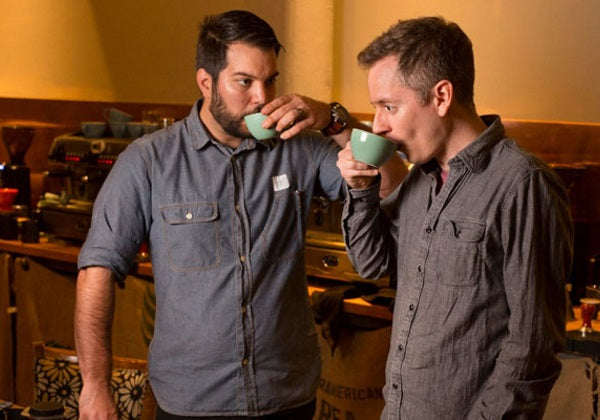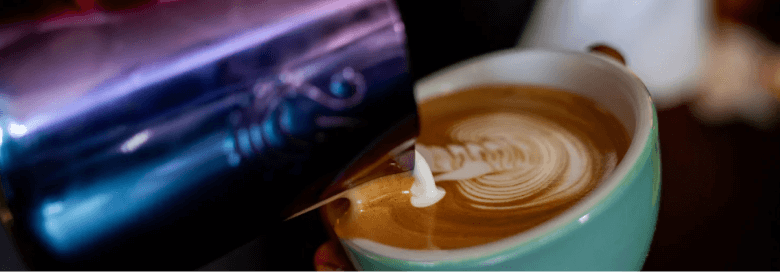Alex meets The Telegraph

Alex Spampinato of 200 Degrees Barista School teaches Telegraph writer Jonny Cooper (right, above) the secrets to good coffee.
I’m going to give you two shots of espresso and they’re going to taste completely different,” says Alex Spampinato. “Your job is to work out why – and you’re not going to get it right.”
Ooh, I like these kinds of challenges. Eyes peeled, hackles up, I watch the professional barista grind some recently roasted coffee beans, press them down, and hook them up to an espresso machine. He hits a button, counts to four, and treacle-thick coffee trickles out, pooling in a small mug below. Spampinato waits a beat, then hands it to me to taste. It’s rich, creamy, nutty and sweet. Perfect.
My challenger returns to his work station. Beans ground, pressed down, into the machine, count to four, small mug below. Wait a beat, over to me. Yuck! It’s thin, bitter; I recoil like I’ve had a shot of bad whiskey.
“What did I do?” asks Spampinato, playing Derren Brown to my stupefied audience member.
I try to think. “The water was a different temperature?” Nope. “The beans were ground differently, or roasted on a different day?” Nope. “You heated the cup first.” Nope. “You’ve hypnotised me and I’m actually in Japan drinking sake?” Long shot. “OK. I give up.”
“I swirled the first one before I handed it to you,” smiles Spampinato. “Told you you wouldn’t get it.”
He takes me back through the process, this time using a clear glass. Once the espresso has finished pouring, I can see it start to cleave in two: the creamy head at the top of the glass pulls at the darker body below. Spampinato says it takes only a flick of the wrist to swirl the two back into one and stop the separation – but there’s a catch. “You have about 10-20 seconds after it’s come out of the machine. After that, the espresso is no good.”
Coffee is like any other food: treat it right and it will repay you in kind
Aside from further marking my card at my local coffee shop, where I’m already known as a nuisance – “I’ll have a short black americano, two shots, easy on the water AND SWIRL THE ESPRESSO” – this demonstration introduces the idea that coffee is like any other food: treat it right and it will pay you in kind; treat it wrong and it can punch you in the palate.
It’s a lesson that we’ve learnt the hard way in Britain. After American soldiers brought over instant coffee in their Second World War ration packs, a mug of coffee in 20th-century Blighty meant desiccated, turbid Nescafé. Even now, 80 per cent of coffee-drinking UK households stock instant – although we are starting to wake up and smell the freshly roasted beans. Such is the demand for good-quality coffee on the high street that a recent industry report warned we’re facing a nationwide barista shortage, with an extra 40,000 trained espresso experts needed in the next six years alone.
And we’ve started taking this newfound coffee addiction home with us, throwing out the instant in favour of “artisan” solutions: roasted bean delivery services, home grinders, and a cupboard full of brewing devices – cafetieres, moka pots, V60s, Aeropresses, and even home espresso machines.
Spampinato’s job today is to give me a crash course in the various extraction methods. “It’s all hands-on,” says the 29-year-old brand ambassador for the 200 Degrees artisan coffee chain. “You’ll make everything, and experience how just brewing coffee changes the way that coffee tastes. The only variable today is the brewing method. Everything else – the amount of coffee, the amount of water, the temperature of the water – stays the same.”
First, the beans. Spampinato emphasises that they should be recently roasted, and only ground just before the coffee is to be brewed. “It’s like opening a pack of crisps. If you open them, have a few, then put the rest back in the cupboard, a few days later the remaining crisps won’t have the same snappiness. Coffee is the same. It ages.”
We ready 17g (the amount 200 Degrees has calculated works best for this particular blend) in a cafetiere and pour over 300g of water. Spampinato starts a stopwatch, waits 30 seconds for the beans to “bloom” – release carbon dioxide trapped in during the roasting process – and then gives the pot a stir to kick-start the brewing. After two and a half minutes we plunge and pour out the coffee. The flavour is floral and light, but it’s also too weak for my liking. I find myself using the word “dishwater” a lot – probably more damning of my palate than the coffee itself.
Next up is the V60, essentially a filter coffee method. Again, there’s a bloom stage, this time with 50g of water, followed by an extra 250g that’s poured in three steps. The coffee that dribbles through is darker, more bodied, but I struggle to identify any tasting notes other than “less dishwatery”.
Where the cafetiere presents a “steeping” method and the V60 a drip-through, the Aeropress – home brewing’s new kid on the block – combines the two. The coffee brews for a couple of minutes and is then forced through a paper filter by a plunger, which brings pressure to the extraction. Immediately, I find there’s more going on in my mouth: an early zesty acidity, balanced out by a sweet honey note that creeps back up my tongue after I swallow.
“That’s what it’s all about,” says Spampinato. “Everyone’s palate is slightly different – and everyone finds a method they like. In the end, it’s the Ikea effect. You value the things that you’ve made well, rather than when it’s made for you.”
